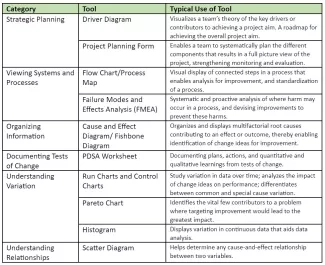Why It Matters
A quality improver requires a kit of essential tools to fix a problem. Experience is helpful to determine which quality improvement (QI) tool to use for what purpose, how to use each one, and when to use them.
QI projects need a planning phase and an implementation phase. Luckily, there are multiple tools in an improver’s toolkit that can address the many questions and challenges that commonly arise in both phases of a project.
The table below shows a snapshot of some of the important QI tools at the disposal of any improver, whether they are a quality improvement newbie or an expert. These tools are pulled together in the IHI Quality Improvement Essentials Toolkit. The Toolkit provides details on how each tool should be used, with examples and templates for deeper understanding.

Adapted from The Improvement Handbook, August 2007 Edition and the IHI's QI Essential Toolkit
For many improvement teams, the choice to develop a driver diagram is essential for planning a roadmap to achieve their overall project aim. But it is important to note that using a driver diagram — like using other QI tools — is part of an iterative process and can be adapted as more learnings arise from the implementation of the project. For example, what was believed to be a secondary driver at the brainstorming design meeting at the start of a project may later be designated as a primary driver after reviewing data or experience in the field.
Sample Driver Diagram
A team in Nigeria started developing their content theory on what would lead to a reduction in obstetric complications with the primary and secondary drivers listed above. As the project progressed, and the team conducted multiple tests of changes, data reviews, and clinical meetings, they realized that Use of Data for Improvement was a stronger factor than they originally anticipated.
As they made changes to improve their data quality, introduced a data deep dive to their clinical meetings, and used visual management boards to keep their performance a burning platform, the drive to address other primary and secondary drivers under their influence grew. This led to improvement in their outcome measure. Use of Data for Improvement became a primary driver in a new driver diagram.
The lesson this team learned was never to leave their driver diagram (or any other tool) cast in stone. Subject matter and profound knowledge on their topic increased and this led to the review and modification of their initial theories.
Choosing QI Tools to Improve Daily Living
One of my favorite things as an improver is using QI tools in my everyday life. Here are a few examples of tools that have helped me organize processes in my home:
- Flowchart — The After School Flowchart was a huge help in making sure my girls went to bed on time even when I was away on a work trip. A flowchart (sometimes called a process map) can be a great improvement tool to use with children because it helps them visualize steps in a process. I believe having them list all the activities, do the writing, and put the chart together definitely helped with their adherence to the process. This kind of “frontline” leadership helps engage any improvement team.
- Fishbone Diagram — We used a fishbone diagram to drill down to the multiple root causes contributing to why we often ran out of my girls’ favorite breakfast foods, eggs and Honey Bunches of Oats cereal. Using the tool helped us identify changing the quantity we stocked and frequency of grocery runs as ways to prevent teary-eyed mornings.
- Aim Statements — Having the kids use aim statements to identify their academic goals and how to attain them served as great motivation for them all through the school year. In addition to personal outcomes, we discussed the joy of lots of goodies from proud grandparents, uncles, and aunties when each year they achieve their aims!
As you explore the many QI tools available, don’t be overwhelmed by the quantity of tools in the QI toolkit. Instead, seek deeper insights into the ways and situations in which these tools are best used.
Feel free in the user comments section below to share your insights about your favorite tools or ask questions about any QI tool.
Kendra Njoku is a member of IHI’s faculty.
You may also be interested in:
Quality Improvement Essentials Toolkit
5 Steps for Creating Value Through Process Mapping and Observation



